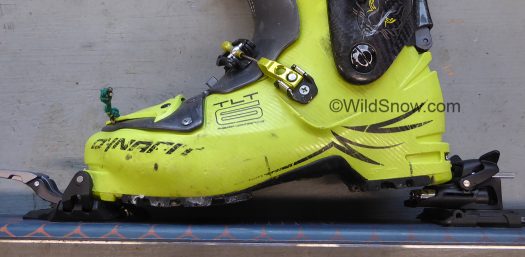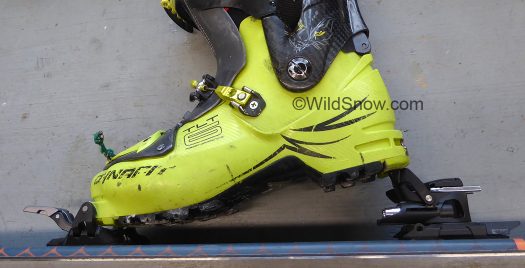I’m been skiing on the TLT Speed binding that’ll be available this fall. Here’s a quick “2-fer” report from the unboxing and mounting stage of the event. (Original blog post covering TLT Speed and Speedfit)
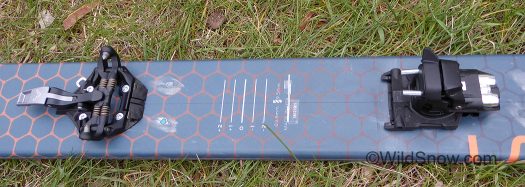
The whole sandwich. Tasty layers, latest Sportiva Vapor is almost too amorphous to to be considered as nutrition. TLT Speed is minimal as well. Funny how this low calorie meal still satisfies. (Binding heel is missing a small cosmetic cap that snaps on to cover the front.)
The names confuse. For example we have the TLT Speed Radical. TLT Speed Turn, and so on. Know that TLT SPEED (with no other prefixes or suffixes) is a new binding from Dynafit for the 2017-2018 season. It’s black, mostly aluminum and plastic, and uses the classic U-spring design that results in a fixed upward-vertical release at the heel while having adjustable side-lateral release.
This same binding design, only slightly heavier, will also be available in the TLT Speedfit. This intended as a lower priced alternative aimed at the fitness uphilling crowd. Both options are at good price points.
TLT Speed: $499
Speedfit: $449
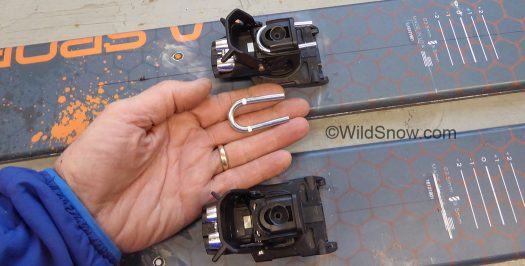
TLT Speed uses the classic U-spring binding design. Clearly this reduces price and weight, but at the cost of no vertical release adjustment.
In my opinion the operative issue with both these competitively priced and nice looking bindings is their release values. TLT Speed has lateral-side release value (RV) catalog stated range of “6-12” (Speedfit version at “5-10”). But, and it’s a big BUT, that’s only the lateral release. Upward (vertical) RV is not adjustable and instead set by the stiffness of the U-spring. Word is TLT Speed will come in at “9.” with the Speedfit providing a “6.”
In the case of my testers, in my estimation they delivered vertical RV at around “DIN” 12 or more, as I couldn’t for the life of me snap my boots in on the workbench, and even had trouble stomping in on the carpet. Admittedly this was a pre-retail pair of test binding. How will the retail U-spring perform? I’m confident Dynafit will deliver something close to the fixed vertical release values they quote. Still — how close that is, related to what you actually require, is going to be something to consider.
For example, say you usually ski your bindings at release value (RV) around 7, and you clip into a TLT Speed that’s around a 9.5. That’s perhaps a compromise you should not make. Conversely, say you’re a big guy and generally ski with your bindings at the proverbial 11!; you might throw a shoe if you’re skiing at RV 9.
(Yes, Virginia I did grind down my stiff U-springs to get the vertical release within tolerable levels. I knew you’d be curious about that. As indeed, everything at WildSnow dot com must be modified. But please do not try that at home. Doing so could dangerously weaken the spring and of course voids warranty.)
Enough of my yammering on about release values. Simply put, these bindings look good, they’re priced reasonable, but be sure the fixed release-retention settings are right for you.
There is a somewhat understated revolutionary aspect to this binding. A T20 star drive adjusts the length, removes the U-spring cap, adjusts the lateral release — and tightens the mount screws. The one tool quiver! Only a few bindings offer this as a feature, and we love it. (That said, we’re not huge fans of T20 binding mount screws. We like pozidrive because it’s designed to cam out with too much torque instead of breaking the fastener or the tool. On the other hand, making everything T20 allows for smaller fastener heads where necessary so I see the point.) Bravo.
The mount. DIY paper jig worked well, but I found it a bit tricky to figure out where the heel unit boot length adjustment should be located since the binding only allows one centimeter of fore-aft adjustment (with possibly a couple mm cheat at either end of the spectrum). If you do a home mount, play around for a while and you’ll figure it out. At the ski shop, Dynafit’s jig will probably do it for you. Be careful.
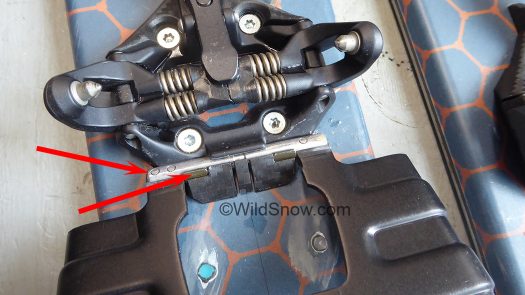
While mounting, take care that the crampon ‘hook’ is located properly. More, some crampons might have rivets that protrude just enough to be inconvenient, knock those down with a file.
TLT Speed crampon mount-hook is similar to that of any Dynafit Radical. As I discovered in my diligent scientific research, it can move a bit when you screw the binding down, thus slightly shrinking the size of the crampon slot. Check this with a crampon while you’re doing the mount. Also, some Dynafit crampons might have the bar rivets protruding a bit high and thus exacerbating a tight fit. Knock those down with a file if necessary.

Yes Jimmy, this is the 2016-2017 version of the venerable Vapor Nano, a bit stronger and skis better, at 1,244 grams that’s only 29 grams heavier than the original white top version. Good test bed that deserves a lightweight grabber.
So, how does everything ski? My first test with any tech binding uphill is how well the toe springs hold without locking. I’d call TLT Speed average in this regard, which is fine. At around 160 pounds I could uphill the binding unlocked until I torqued fairly hard — that’ll work for tiptoeing in avalanche terrain. Next, boot heel lifters. You can get three practical (and four if you push it, see photos) heel heights from the TLT Speed. Rotate heel unit so pins are pointing rearward, with lifters stowed you’ve got nearly flat-on-ski boot delta. Flip the two lifters for a medium height and moderately high that’s fine for any reasonable skin track. Flipping the lifters with a ski pole basket is difficult, pole grip works better. Downhill, they felt like any other classic tech binding: a little soft at the heel yet entirely functional. However, note this type of heel construction results in significantly less “micro play” than many other tech binding heels. How much that really changes how they ski is an open question, but it does inspire confidence.
Whoops, almost forgot the skis. I’ll file a real review, but for now can say they’re indeed improved over the original Vapor Nano. Less nervous, more versatile. I don’t usually ride skis this fat, but these could change my habits. Only downside is with this much tip and front rocker I need the 179 cm length, and kick turns are hard with that much tail in the way. I like something just a few centimeters shorter. Details.
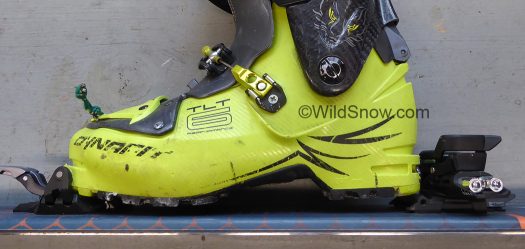
By rotating the heel unit to the side you can get a sort of faux heel super-flat mode. This is more in theory than practice, as the heel unit ends up just a few millimeters from boot heel and part of the binding overhangs the side of all but widest skis. Lowest practical heel lift is fine, it’s almost flat (see image below) and perfect for lowest angles on most uphills. Medium and high lifts are nicely designed.
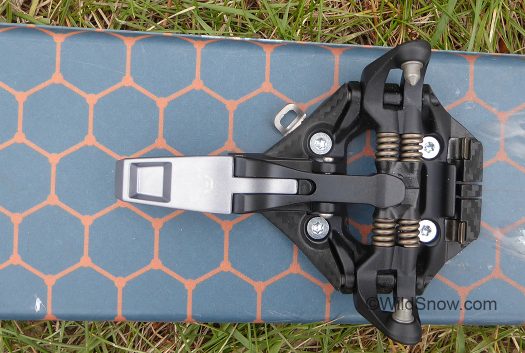
Toe is virtually a Radical 1.0, with a leash mount and noticeably lower on the ski by about 4 millimeters. Toe uses same screw hole pattern as all Dynafit Radical 1st generation. Heel is low as well; binding has a reasonable ramp angle in downhill mode. See our chart. The “wing springs” are stiff.
Conclusion: In either the TLT Speed or Speedfit version, a reasonably priced ski touring binding. Weight and configuration that’s totally doable. Some concerns about vertical release values. Care required during mount due to limited boot length adjustment range. Available brakes a plus for people wanting a worry free setup. Yet another reason to quit riding ski lifts.
TLT Speed total scale weight, no brake, with screws, 308 grams.
Toe unit weight, no screws, 116 grams.
Heel unit weight, no screws, 164 grams.
Ski brake stopper available, 75,90,105 mm.
Release values (RV) for retail version: Fixed upward said to be RV of 9, lateral adjustable 6-12
I already lashed up a paper mount template.
WildSnow.com publisher emeritus and founder Lou (Louis Dawson) has a 50+ years career in climbing, backcountry skiing and ski mountaineering. He was the first person in history to ski down all 54 Colorado 14,000-foot peaks, has authored numerous books about about backcountry skiing, and has skied from the summit of Denali in Alaska, North America’s highest mountain.

